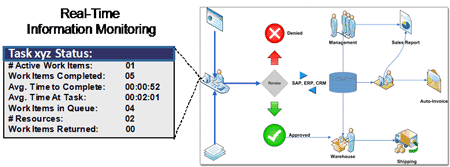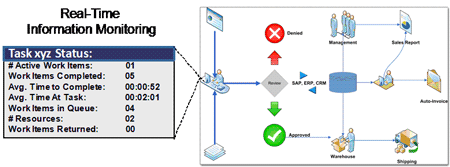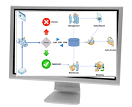
Documents; The Neglected Side of Business Information Automation
Many organizations today are looking inward to streamline their processes and increase efficiency. Traditionally, much of their emphasis has been focused on developing or acquiring high tech business automation solutions, while improvements regarding business processes and the documents that flow through them have been largely ignored.
People, processes, paper and technology must work together in an environment that promotes collaboration and accountability in order to maximize effectiveness and efficiency. Most organizations forget to include all relevant information involved in a business process while working in a digital environment.
Most of it is locked and hidden away in unstructured documents – email, diagrams, notes, spreadsheets and other amorphous silos of information. All are important pieces when preparing the foundation of a business decision and should be quickly accessible to everyone involved.
All too often, an electronic Document Management (eDM) solution is implemented and placed at the end of the process, performing only as an archival virtual filing cabinet. Following the Six Sigma methodology of DMAIC – Define, Measure, Analyze, Improve, and Control – a business analyst can help their company place the eDM initiative at the front of the process, as paper and electronic documents are received, so that eDM technology may benefit and improve the entire business process for significantly greater value and return-on-investment.
Define and Measure: The Significance of Documents
Fundamentally, there are many types of documents considered as evidence of a business transaction. Although this information may be transcribed into an organization’s database, there are legal/compliance reasons that companies must protect, retrieve and produce these documents on a routine or on-exception basis.
Much of the manual daily business activities involve handling and preparing documents for processing, using database applications as well as when performing operational tasks. Unfortunately, companies today are unaware of the eDM systems potential and simply file paper or electronic images of these documents in ways that make accessing and working with them both cumbersome and time consuming.
Common Problems in Companies Today
-
“Is the document I need an email, fax, word-processor, spreadsheet, drawing, photo or paper and whose file is it in?”. After determining it is in Sarah’s possession – “Sarah is on vacation and I don’t have a key to her desk or her email/fax/computer password to find it now”.
-
“I can’t find/read your fax, please resend it” A terrible thing to say to your customer. This is done every day in many companies, not just once, but more than once to the same customer for the same fax!
-
When auditors request that all materials related to a particular account be collected, it can be a nightmare to try to bridge all the different paper, email, fax and disk filing silos to search.
-
How does a company ensure privacy compliance when an email on the subject may have been electronically forwarded and replied to many different individuals/email boxes, creating and duplicating potentially sensitive data? How can you be sure the data is fully-removed or complies with retention policies?
-
“I have worked here for five years and I’m proud to say I’ve never deleted an email.” Microsoft Exchange and similar email systems were designed to communicate messages — not to archive emails and attached documents forever.
It is important to note that traditional “paper-shuffling and frantic-file searches” also apply to electronic files such as email, faxes and digital documents.
Analyze and Improve: Addressing the Document Information Gap
We begin addressing the document information gap by identifying untraditional document types involved in a business decision, which are needed in the overall design of the enterprise’s document management system. The establishment of a common Document Repository eliminates information silos, allowing documents to be easily searched for and shared by order of relevance – regardless of their origin, paper, email, fax, office-tool generated, etc.
A well designed eDM solution establishes the foundation needed for an efficient electronic Workflow (eWorkflow) solution to help improve and streamline business processes. In order to maximize the potential of the eDM solution, the business analyst must take steps to document a clear understanding of the current processes and goals. Then it is possible to look objectively at the opportunities to formulate a clear vision for the improved and automated business processes.
Once this vision has gained consensus of management and staff, today’s eDM solutions make it possible to prototype eWorkflow solutions that model the integration of eDM systems with actual business processes. These solutions provide higher-level workflow specifications appropriate for both technical and non-technical business analysts.
-
Visual eWorkflow Modeling is easy for the business analyst to define and for the impacted staff to understand. The visual eWorkflow process models can then be prototyped and tested allowing the business analyst and staff to understand the process and see it in action. This interactive experience allows each process to be verified and further refined by rapid iteration until it is right.
-
The business analyst is typically able to simplify processes, eliminate steps that add no business value and reduce the number of required processes by focusing on the mainstream processes. As a result, the eWorkflow designs are likely to have fewer exceptions
-
However, since exceptions are a normal part of business, the eWorkflow solution provides standardized methods and tools for handling them such as:
-
Auto-Reroute & Alert Mechanisms that are triggered by a business rule violation or time-limit timeout or specified condition that take a specified action, route to a pre-defined general exception process or generate an alert-message notice via email.
-
When more than one document must be present before performing the next eWorkflow step processing, the order in which the documents arrive at the workflow step is not important, but once all required documents are present and available processing can continue at the next step. Should too much time elapse, and one or more required documents have not appeared, then an auto-reroute or alert mechanism is triggered to insure that the exception is properly handled.
-
Measure and Control: Automated Process Information Metrics
New real-time design and control mechanisms are being introduced in today’s advanced eDM/eWorkflow solutions:
-
Business analysts are able to create Visual eWorkflow and staff can easily understand and use the improved business processes being defined.
-
Users working under an eWorkflow solution::
-
Can easily see their assigned work for one or many different types of processes in their browser window. o Provide a heads-up display of key procedural steps to be followed when working on a particular document.
-
Require no programming knowledge to define business rule routing logic, so that work can effectively be tracked and delivered to the right people each time.
-
-
Operational supervisors can use the visual representations of eWorkflow to monitor in real-time, information regarding individual processing performance statistics, number of assigned resources, identify process bottlenecks and for each process/task view the number of work-items:
-
Completed
-
In-Process
-
Pending Processing

-
-
Advanced functionality can help supervisors reassign resources allocated to a process on-the-fly:
-
For a temporary period or permanently o Staff may continue to serve previously-assigned
 processes as well as the new assignment
processes as well as the new assignment
-
Unlike traditional, workflow that routes to specified workstations or individuals, modern routing is done to defined processes where User-Roles or Resources can be assigned to specified processes where human intervention is needed.
-
-
Extensive on-demand reports are defined and others may be created with high-level report generation tools by business analysts and/or knowledgeable operational staff.
Summary
Despite the widespread usage of database applications, business processes are typically poorly documented and have many processing exceptions, ad hoc and inconsistent procedures. To some extent, this is due to the fact that documents have been neglected in the overall design of information systems.
By taking advantage of the many new advances in eDM and eWorkflow technology as well as the steep declines in the cost of computers, storage and networking, it is practical to consider integrating documents and business applications into functionally-complete business process automation systems.
Many of today’s eDM solutions are web-enabled and allow documents to be efficiently captured, shared, processed, stored and displayed from virtually anywhere an Internet connection is available. Tight integration of eDM with business process, central access for all document stakeholders, and enhanced real-time business process controls are just a few of the gains that can be realized when document automation is incorporated into the overall design of business systems.
Note: The iDatix iSynergy electronic Document Management (eDM) and Progression electronic Workflow (eWorkflow) solutions have been successfully used by Point North Consulting to address these issues and provide the described functionality presented in this paper.
Mark Crandall is a Senior Director and the President of Point North Consulting in Orlando, FL. He has more than fifteen years experience with business process improvement and information management. Mr. Crandall has a proven track record gathering and analyzing requirements, translating requirements into efficient design implementation projects, and managing the initiatives through the development life cycle to achieve streamlined business processes. Before forming Point North Consulting, Mr. Crandall was the CEO/Owner of Crandall Technologies, a consulting firm in Gainesville, FL (1996-2000), serving small to medium sized businesses with a focus on Business Process Re-engineering, Technical Architecture, Data Mining, and Business Intelligence.
Mr. Crandall was educated at the University of Florida, studying Materials Science Engineering and Business Administration as an undergraduate. After being accepted to University of Florida’s Masters Program in Decision and Information Sciences (DIS), Mr. Crandall was invited to participate in the selective Ph.D.program in DIS. He completed the coursework for the degree, but opted to enter the business sector to consult small and medium-sized businesses full time.